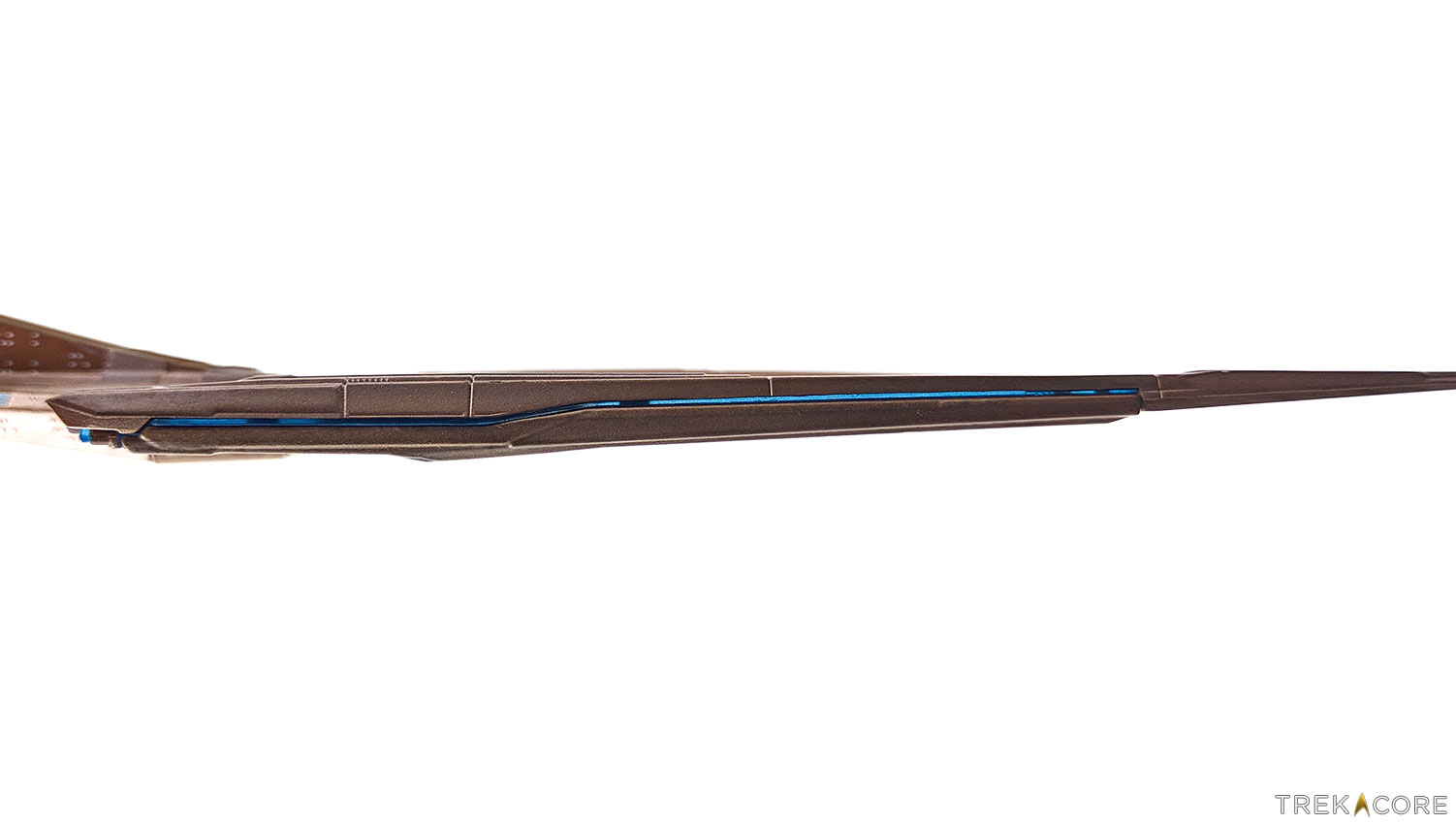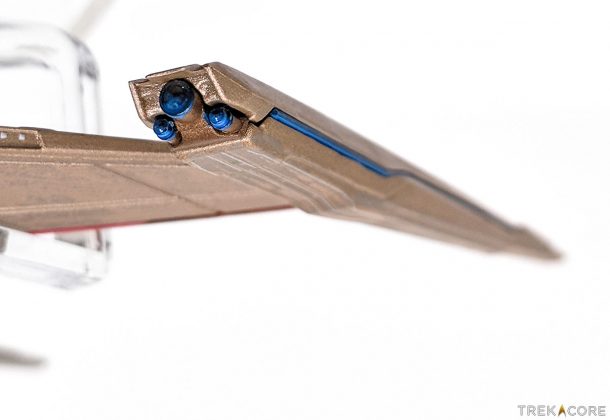Eaglemoss’ first starship model from their new Official Star Trek: Discovery Starships Collection line arrived in early February with the Walker-class USS Shenzhou, and like the series itself, the hero ship of Star Trek: Discovery arrives second in line.
The Crossfield-class USS Discovery has slowly begun to arrive into the hands of collectors, and the 10″ model spore-jumped into our sector this weekend as the company prepares for the upcoming wide release of the new starship.
While it doesn’t spin up like the ship seen in the series, the Discovery model includes the tri-hulled saucer design, triangular secondary hull, and long, spindly warp nacelles that makes the Crossfield-class one of the most unique starship design seen in the Federation Starfleet to date.
Its copper-toned hull is offset by deep bronze detailing around the inner ring surfaces, the bridge module, and the secondary hull, with the ship’s registry markings detailed in a yellowish-wheat color that’s just a bit too faint for our taste — while it is perfectly legible in the above photo, direct lighting on that front saucer makes it quite difficult to read thanks to the metallic finish on the model. (A slight outline surrounding the lettering, as seen on the ‘real’ Discovery, would certainly help in that regard.)
The bridge module is well-sculpted, with its five-sided dome lighting cleanly painted, however the front viewscreen window is rendered here with a pair of paint dots rather than a rectangular marking.
Underneath the saucer lies the blue forward-facing accents on the ship, the central deflector dish, dual-placed intake manifolds, and the three-lobed bussard collectors on the front of the warp nacelles.
As with just about all of Eaglemoss’ Star Trek starships, the model is made up of a combination of die-cast metal and plastic elements, which sometime can allow for some noticeable seams where the two materials come together; the underside of the starship has several metal and plastic parts coming together which does create a bit of a gap around the central deflector area.
The largest parts of the secondary hull (extending to the underside of the nacelles) are die-cast metal, which really allows for the diagonal highlights on its surface to really shine as ‘duranium’ constructs, giving the ship a bit of reflectivity where the bright copper elements appear – though the central plastic spine again can allow for a bit of a join gap.
The rear impulse engine assembly and cargo bay / shuttlebay doors are all one piece of molded, semi-transparent plastic, glued securely into the three-sided interior surface of the ship’s aft section; hold the ship up to light and you’ll see a bit of a glow shine through the entire component.
The warp nacelles themselves are plastic and metal constructs, with a quite nice blue transparent element sandwiched in there to allow for a tiny amount of warp glow in the right lighting.
With the size of these nacelles, such a thin bit might normally be left to be a painted element (like the forward intake strips), but here the effort to include the transparent inserts is an appreciated touch.
The underside of the ship is a bit sparse, with proper aztecing and appropriate hull markings, but lacking in windows or other more expected structural details (sensor pallets, escape pod hatches, etc.) that have become a staple of the Eaglemoss models.
Since these ships are coming right out of CBS’s digital servers, however, that’s not something we’ll lay on Eaglemoss, who has done a rather marvelous job (with few exceptions) of mirroring the USS Discovery we’ve seen on television this year.
 Okay, okay, we get it — you want to know about the windows.
Okay, okay, we get it — you want to know about the windows.
Unlike most of the Federation ships released by Eaglemoss, there really aren’t that many windows on the Discovery model, but the ones that are unfortunately face more of the same issues as the previous starships we’ve profiled.
The sides of the secondary hull and inward-facing surfaces of the saucer rings are the primary locations of molded windows, and in both places, the white window markings are significantly out of alignment with the textured detailing.
While the underside of the saucer rings might be the most egregious area to face this problem, we’ll say that unless you’ve got direct lighting pointed at the underside of the ship, it’s not terribly obvious thanks to the reflective nature of the hull paint which helps obscure some of the white paint around the windows.
(Our model also has a slight paint issue with the underside’s hull registry, likely not repeated on most other copies of this release.)
Overall, while this version of Discovery has its minor issues, Eaglemoss’ efforts on this first-to-fulfillment Crossfield-class ship are pretty remarkable, considering the ship didn’t even make its first on-screen appearance until last October.
While there may be more detailed versions of this ship released by other vendors in the future — like that $9,000 custom build from ANOVOS — this one seems to be just about right for the size and price point offered by Eaglemoss.
Here’s our full gallery of photography:
The USS Discovery model is available as part of Eaglemoss’ Official Star Trek: Discovery Starships Collection subscription, and can also be purchased directly in the US for $54.95 or in the UK for £34.99 and will be shipping soon to non-subscription preorders.
For those of you looking for a bit of a deal, the Discovery model subscription advertises that subscribers can get the Shenzhou for $9.95, followed by the Discovery and future monthly releases for a discounted rate of $45 each.
![]()
We’ll be back soon with a look at some of the next specials in the Official Starships Collection line – so keep coming back to TrekCore for the latest news and reviews!


















